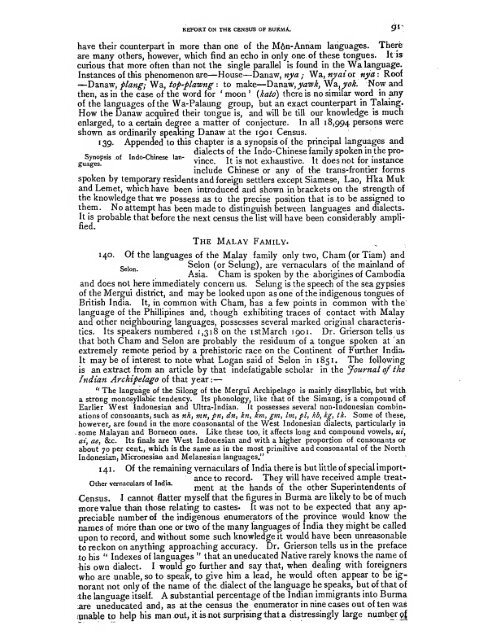Burma: Census of India 1901 Vol. I - Khamkoo
Burma: Census of India 1901 Vol. I - Khamkoo
Burma: Census of India 1901 Vol. I - Khamkoo
You also want an ePaper? Increase the reach of your titles
YUMPU automatically turns print PDFs into web optimized ePapers that Google loves.
—<br />
REPORT ON THE CENSUS OF BURMA.<br />
S^<br />
have their counterpart in more than one <strong>of</strong> the M6n-Annam languages. There<br />
are many others, however, which find an echo in only one <strong>of</strong> these tongues.<br />
It is<br />
curious that more <strong>of</strong>ten than not the single parallel is found in the Wa language.<br />
Instances <strong>of</strong> this phenomenon are— House—Danaw, nya; Wa, nyai or nya: Ro<strong>of</strong><br />
—Danaw, plang; Wa, lop-plawng : to make—Danaw, yawk, Wa,jfli. Now and<br />
then, as in the case <strong>of</strong> the word for moon ' ' (kato) there is no similar word in any<br />
<strong>of</strong> the languages <strong>of</strong> the Wa-Palaung group, but an exact counterpart in Taking.<br />
How the Danaw acquired their tongue is, and will be till our knowledge is much<br />
enlarged, to a certain degree a matter <strong>of</strong> conjecture. In all 18,994 persons were<br />
shown as ordinarily speaking Danaw at the 190 1 <strong>Census</strong>.<br />
1 39. Appended to this chapter is a synopsis <strong>of</strong> the principal languages and<br />
dialects <strong>of</strong> the Indo-Chinese family spoken in the proguag<br />
n PS 'S ° a ""<br />
es<br />
yir.ce. It is not exhaustive. It does not for instance<br />
include Chinese or any <strong>of</strong> the trans-frontier forms<br />
spoken by temporary residents and foreign settlers except Siamese, Lao, Hka Muk<br />
and Lemet, which have been introduced and shown in brackets on the strength <strong>of</strong><br />
the knowledge that we possess as to the precise position that is to be assigned to<br />
them. No attempt has been made to distinguish between languages and dialects.<br />
It is probable that before the next census the list will have been considerably amplified.<br />
The Malay Family.<br />
140. Of the languages <strong>of</strong> the Malay family only two, Cham (or Tiam) and<br />
. Selon (or Selung), are vernaculars <strong>of</strong> the mainland <strong>of</strong><br />
s<br />
Asia. Cham is spoken by the aborigines <strong>of</strong> Cambodia<br />
and does not here immediately concern us. Selung is the speech <strong>of</strong> the sea gypsies<br />
<strong>of</strong> the Mergui district, and may be looked upon as one <strong>of</strong> the indigenous tongues <strong>of</strong><br />
British <strong>India</strong>. It, in common with Cham, has a few points in common with the<br />
language <strong>of</strong> the Phillipines and, though exhibiting traces <strong>of</strong> contact with Malay<br />
and other neighbouring languages, possesses several marked original characteristics.<br />
Its speakers numbered 1,318 on the istMarch <strong>1901</strong>. Dr. Grierson tells us<br />
that both Cham and Selon are probably the residuum <strong>of</strong> a tongue spoken at "an<br />
extremely remote period by a prehistoric race on the Continent<br />
<strong>of</strong> Further <strong>India</strong>.<br />
It maybe <strong>of</strong> interest to note what Logan said <strong>of</strong> Selon in 1851. The following<br />
is an extract from an article by that indefatigable scholar in the Journal <strong>of</strong> the<br />
<strong>India</strong>n Archipelago <strong>of</strong> that year :<br />
" The language <strong>of</strong> the Silong <strong>of</strong> the Mergui Archipelago is mainly dissyllabic, but with,<br />
a strong monosyllabic tendency. Its phonology, like that <strong>of</strong> the Simang, is a compound <strong>of</strong><br />
Earlier West Indonesian and Ultra-<strong>India</strong>n. It possesses several non-Indonesian combinations<br />
<strong>of</strong> consonants, such as nh, mn, pn, dn, in, km, gm, Im, pi, kb, kg, tk. Some <strong>of</strong> these,<br />
however, are found in the more consonantal <strong>of</strong> the West Indonesian dialects, particularly in<br />
- some Malayan and Borneon ones. Like these too, it affects long and compound vowels, ui,<br />
at, ae, &c. Its finals are West Indonesian and with a higher proportion <strong>of</strong> consonants or<br />
about 70 per cent, which is the same as in the most primitive and consonantal <strong>of</strong> the North<br />
Indonesian, Micronesian and Melanesian languages."<br />
141. Of the remaining vernaculars <strong>of</strong> <strong>India</strong> there is but little <strong>of</strong> special import-<br />
. , .. ance to record- They will have received ample treat-<br />
Other vernaculars <strong>of</strong> lnd,a.<br />
^^ ^ ^ ^^ rf ^ ^^ Superintenden ts f<br />
<strong>Census</strong>. I cannot flatter myself that the figures in <strong>Burma</strong> are likely to be <strong>of</strong> much<br />
more value than those relating to castes- It was not to be expected that any appreciable<br />
number <strong>of</strong> the indigenous enumerators <strong>of</strong> the province would know the<br />
names <strong>of</strong> more than one or two <strong>of</strong> the many languages <strong>of</strong> <strong>India</strong> they might be called<br />
upon to record, and without some such knowledge it would have been unreasonable<br />
to reckon on anything approaching accuracy. Dr. Grierson tells us in the preface<br />
to his " Indexes <strong>of</strong> languages " that an uneducated Native rarely knows the name <strong>of</strong><br />
his own dialect. I would go further and say that, when dealing with foreigners<br />
who are unable, so to speak, to give him a lead, he would <strong>of</strong>ten appear to be ignorant<br />
not only <strong>of</strong> the name <strong>of</strong> the. dialect <strong>of</strong> the language he speaks, but <strong>of</strong> that <strong>of</strong><br />
Ihe language itself. A substantial percentage <strong>of</strong> the <strong>India</strong>n immigrants into <strong>Burma</strong><br />
are uneducated and, as at the census the enumerator in nine cases out <strong>of</strong> ten was<br />
omable to help his man out, it is not surprising that a distressingly large number oj

















